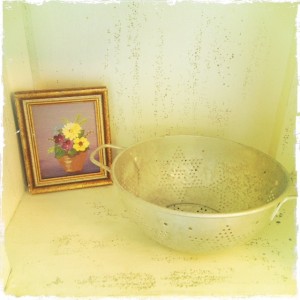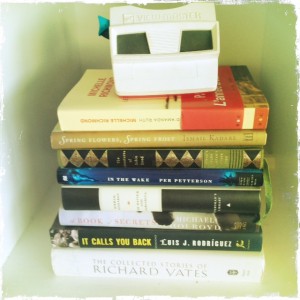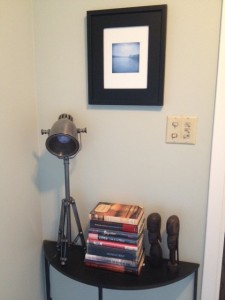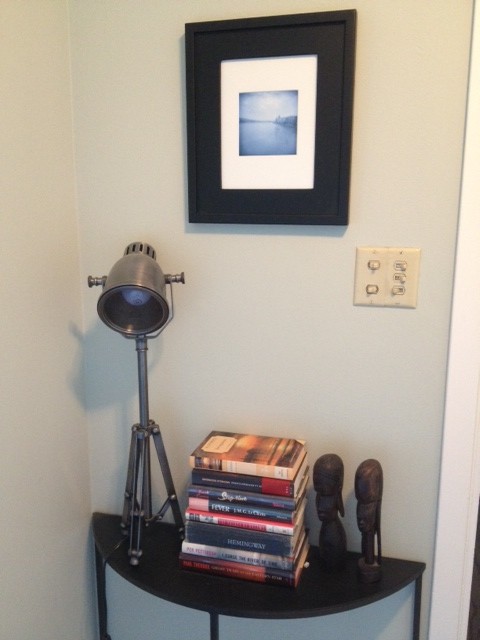
The September challenge in Gretchen Rubin’s Happier at Home focuses on possessions. Gretchen challenges the popular mandate to simplify your life by getting rid of everything that isn’t essential. Rubin argues that possessions–those that have sentimental value, or those that are useful, or those that serve symbolically to remind us of our relationships with people we love–can actually bring a kind of happiness.
Rubin is inspired by her daughter, Eleanor, who keeps little collections of her treasures throughout the apartment.

Following her daughter’s lead, Rubin creates her own shrine–a shrine to work. She transforms her office with a painted mural on the wall, which does, she finds, bring her a degree of happiness while she is working.
As much as I try (unsuccessfully) to eliminate clutter in my home, I also believe in keeping things. Not all of the things I keep are useful every day, but many of them bring me happiness. Take, for instance, my grandmother’s old tin colander (pictured above). After my grandmother died, my dad sent me a box with some items from her house–among them, the colander, which brings me happiness because it reminds me, every time I glance at it, of the dear country lady who showed her love by cooking. Next to it, a little painting that I purchased from Goodwill. The painting doesn’t have sentimental value, but it struck me when I saw it, and I love the simplicity and innocence of it. Looking at it makes me happy.
Click READ MORE to continue reading How to Cultivate a Shrine.

Another item that came in that box from my dad was the viewmaster we used to play with when we were kids. There isn’t a single room in our house that could pass as “formal,” because we’re very casual, and it’s important to us to live in every room, for our son to feel comfortable making a creative mess anywhere while he plays or entertains his friends. In that vein, the living room shelves are filled with books, nothing breakable or priceless. And on top of one pile of books is the Viewmaster.
Our entryway is also characteristically informal–just a small Room & Board table on which stands a few books, including the Russian edition of The Year of Fog and Frank Conroy’s achingly beautiful memoir, Stop Time (a reminder that we can’t, so we should appreciate every second as it occurs), and a novel by the Norwegian writer Per Petterson. Beside the books is a pair of carved statues that my husband purchased from the man who made them in Kenya in 1998. At the time, we were dating and living together in New York. I happened to be in China for a few months while he was in Kenya, and I missed him so terribly. Those statues are a reminder of that time, when we were just beginning to build our lives together. Above the small tableau hangs a photograph of the Danube in Budapest, where we honeymooned in 2001.
At the time, we couldn’t have imagined that we’d be the age we are now, or that we’d be living here, or that any number of the things that have happened to us would happen. While we expected we would have a child, we of course couldn’t have begun to imagine our particular child–who he would be, and how much happiness he would bring us (nor that we would end up traveling with him to Norway, homeland of favorite author Per Petterson, who so saliently declares “I curse the river of time.”). A shrine is a monument to time, to the lives you’ve lived together. In this way I believe that yes, possessions can bring you a kind of joy, insomuch as they represent where you have been, and where you are going.

And while overconsumption is unlikely to make anyone feel better, a wisely chosen item that brings fun or practicality into your life (Rubin cites skis as an example) doesn’t have to be a bad thing. While our home is sparsely decorated, I do occasionally purchase something that, due to its whimsy or beauty or both, fits nicely into the way we live every day. I happen to be a sucker for lamps. This may have something to do with my obsession for reading. Every comfortable chair or sofa in our house is illuminated, because at any moment, one of us might plop down with a book.. (This one is from One Kings Lane). I love the shape, the simplicity, and the texture.
Gretchen admits that she forms attachments not only to family mementos, but also to thoughtfully acquired items, which over time find their own place and importance in her home.
The bottom line: while possessions in and of themselves are unlikely to make you a happier person, well-chosen things that fit the way your family lives will make your home feel more homey, and just a little bit happier.
Readers: what do you keep for sentimental reasons? What kind of shrines already exist in your home? What are you willing to splurge on to create a more harmonious home?

